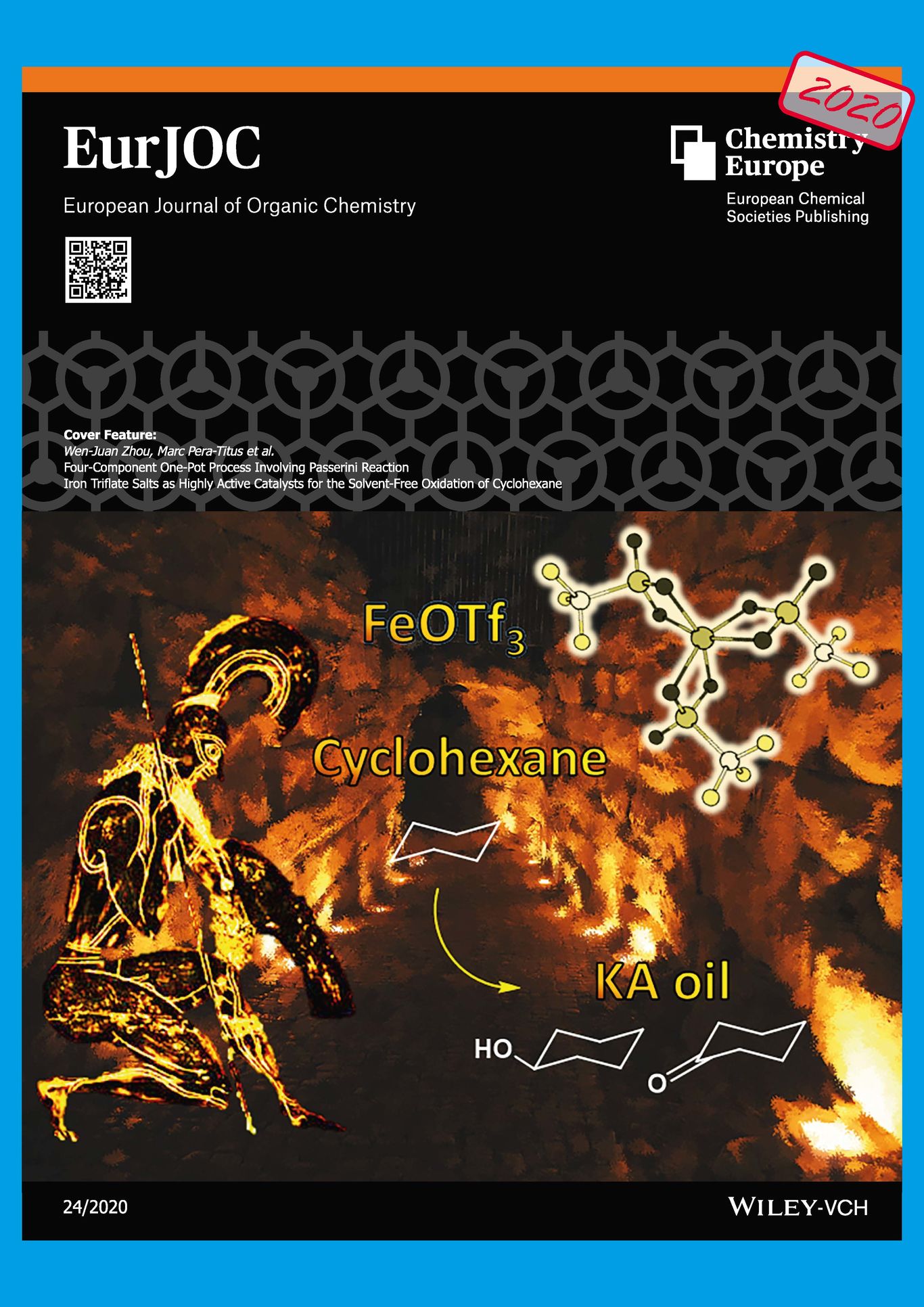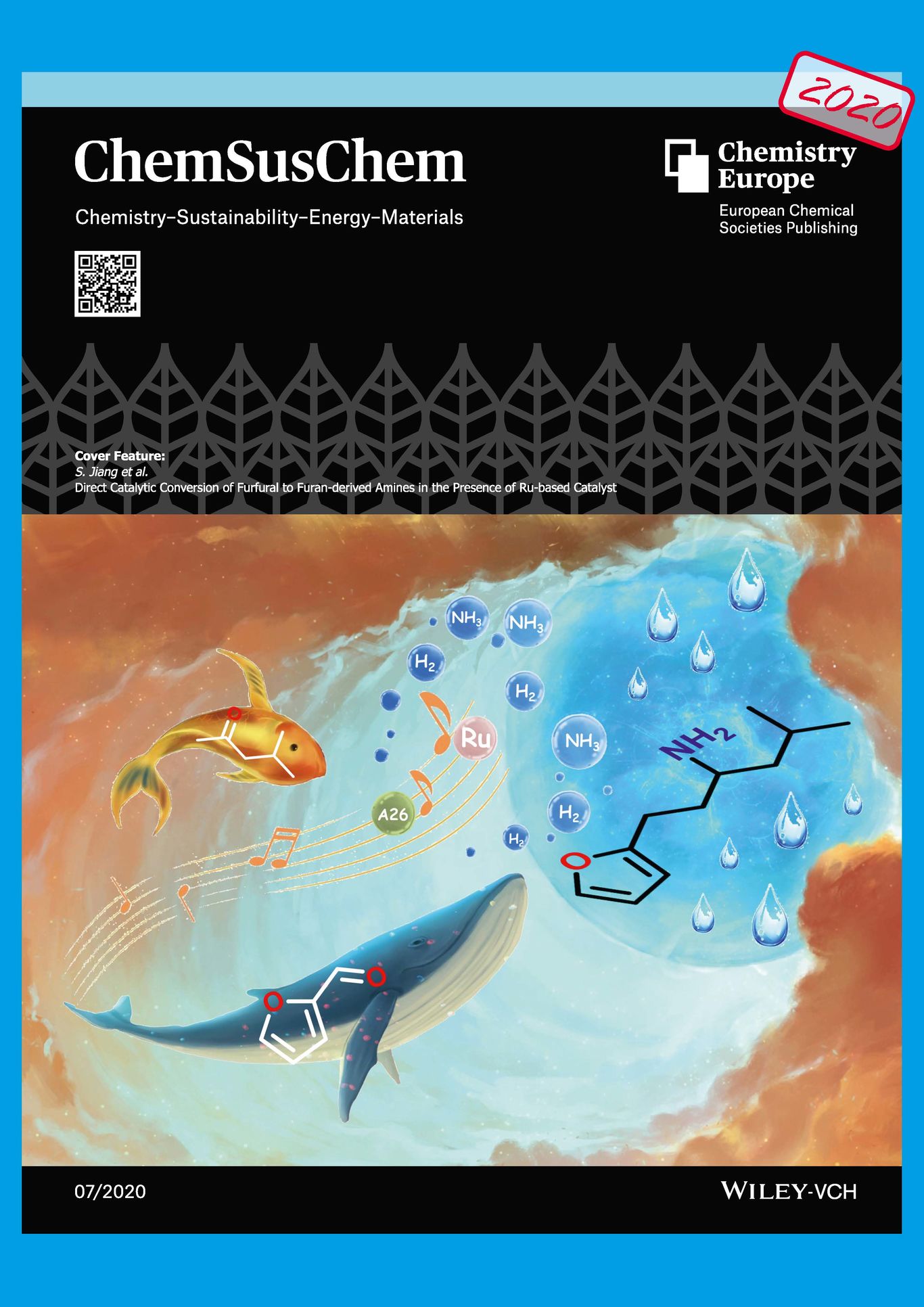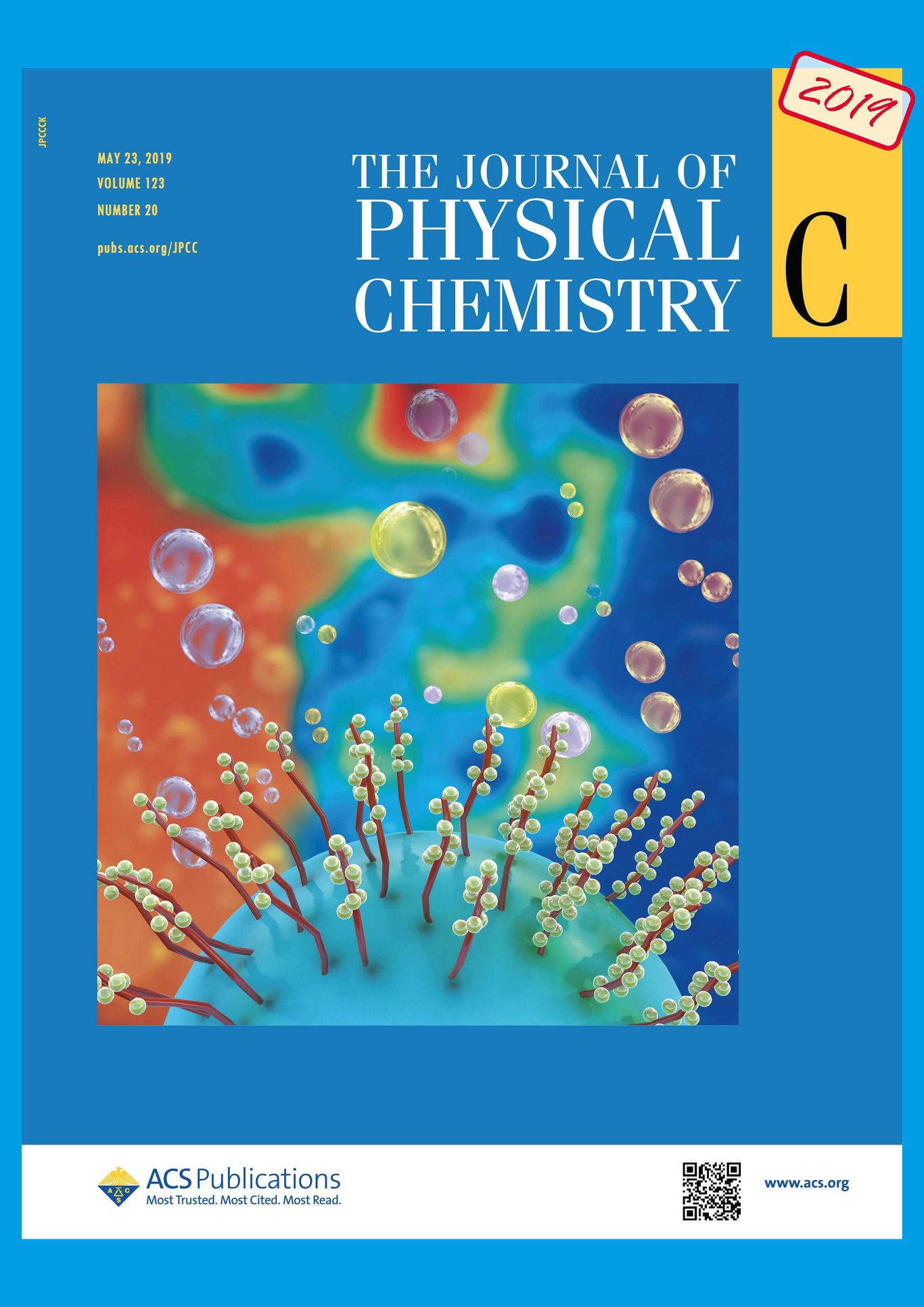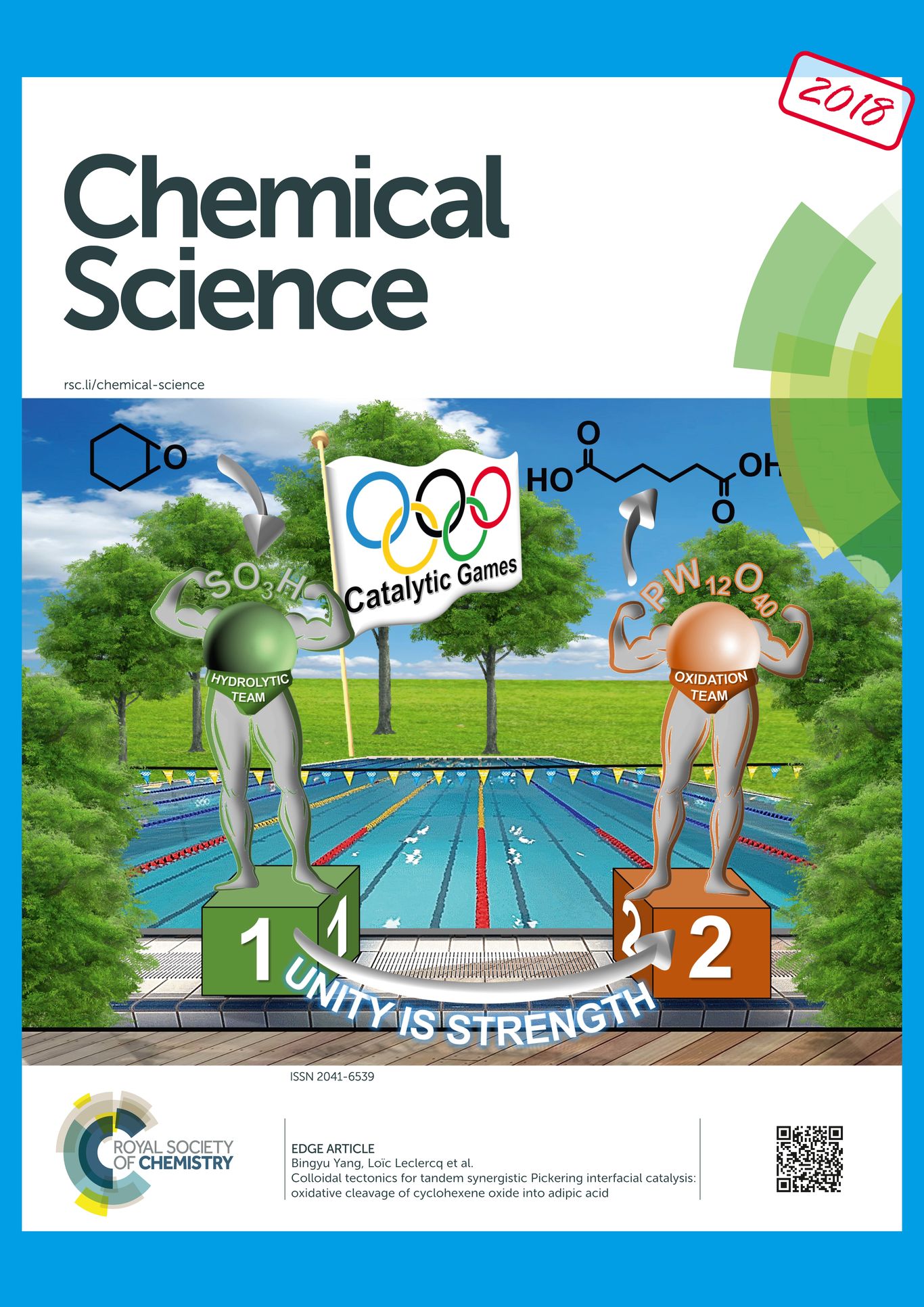2020 patents
- 17 patent applications
2020 publications
Y. Li, G. Zhao, B. Hong, S. Zhao, X. Han, M. Pera-Titus, Colloids Surf A. (2020), 599, 124800.
Abstract
Pickering Interfacial Catalysts (PIC) has emerged as a powerful concept for designing multiphasic reactions between immiscible reagents using heterogeneous catalysts. Nonetheless, systematic studies addressing the influence of the particle self-assembly on the catalytic properties are scarce. To fill this gap, here we studied the effect of the particle size and surface roughness of catalytic nanoparticles on the reactivity of non-aqueous immiscible systems in the presence of Pickering emulsions. To this aim, we prepared a library of amphiphilic silica nanoparticles with the same surface properties and bearing catalytically active acid centers, but showing variable particle sizes in the range 90-460 nm and surface roughness. The nanoparticles were characterized in detail using different techniques, including acid-base titration, TGA, TEM and DLS. The silicas were tested in the biphasic acetalization reaction of dodecanal and ethylene glycol.
The catalyst productivity was enhanced for smaller sized nanoparticles (<210 nm) as a result of the formation of more stable ethyleneglycol-in-dodecanal emulsions along with larger interfacial surface areas and a more compact interfacial self-assembly of particles. By contrasting the experimental emulsification results with dissipative particle dynamics simulations combined with the generalized Young equation, the particle-size dependence of ethyleneglycol-in-dodecanal emulsions could be explained by a stabilizing role of the line tension. The surface roughness of the particles was found to be detrimental for emulsion stability, but its negative effect was largely compensated by the stabilizing role of the line tension, especially for smaller particles. Overall, the particle size exerts a more prominent effect than the surface roughness on emulsion stability and interfacial catalysis for the ethyleneglycol/dodecanal system.
P-A. Payard, C. Finidori, L. Guichard, D. Cartigny, M. Corbet, L. Khrouz, L. Bonneviot, R. Wischert, L. Grimaud, M. Pera-Titus, Eur. J. Org. Chem. (2020), 22, pp. 3219-3224
Abstract
Herein we report a new “in silico Beckett–Childs method” affording a DFT‐computed descriptor of Lewis acidity based on the partial charge build‐up of phosphine oxide coordinated to a Lewis acid. When applied to a broad series of triflate and triflimide salts, this descriptor afforded good correlation with the catalytic activity for the model amination reaction of benzyl alcohol with aniline, enabling the computational design of a new TiIII triflimide salt.
P-A. Payard, C. Finidori, L. Guichard, D. Cartigny, M. Corbet, L. Khrouz, L. Bonneviot, R. Wischert, L. Grimaud, M. Pera-Titus, Eur. J. Org. Chem. (2020), 22, pp. 3225-3228
Abstract
The reactivity of a new titanium triflimide salt (see Part 1) was investigated for the direct amination of alcohols. The combination of this new Lewis acid with pyridine‐based ligands allowed a significant increase of activity. The scope of the reaction was increased compared to other Lewis‐acid‐based protocols. Finally, mechanistic insights based on EPR spectroscopy and DFT calculations are provided.
Y. Yin, X. Lu, J.Yin, F. Su, S. Streiff, H. Xu, P. Wu, Micro. Meso. Mater. (2020), 305, 110321-110329.
Abstract
The MSE-type aluminosilicate UZM-35 was efficiently prepared via adding a rational amount of MCM-68 as seed and using commercially available dimethyldipropylammonium hydroxide (DMDPAOH) as the structure-directing agent. The operation window of Si/Al ratio was widened significantly and the synthetic system was less sensitive to the Na+/K+ ratio, compared to the synthetic systems of MCM-68 and traditional UZM-35 without seed. The crystallization time was also shortened to 4 days, compared to MCM-68 (14 days) and traditional UZM-35 (7 days). Moreover, the framework of UZM-35 kept intact after the dealumination process including high temperature calcination and acid treatment. Tetrahedrally coordinated Ti4+ ions were introduced into the framework of highly dealuminated UZM-35 via solid-gas reaction with TiCl4 vapor and the obtained Ti-UZM-35 exhibited comparable catalytic activity to Ti-MCM-68 in the phenol hydroxylation reaction. The H2O2 feeding style was adjusted in present work to improve the H2O2 utilization efficiency up to 70%. In addition, the Ti-UZM-35 catalyst was stable in the regeneration-reuse cycles.
I. Scodeller, K. de Oliveira Vigier, E. Muller, C. Ma, F. Guégan, R. Wischert, F. Jérôme, ChemSusChem (2020), 14, 313-323.
Abstract
The synthesis of relevant renewable aromatics from bio‐based furfural derivatives and cheap alkenes is carried out by using a Diels‐Alder/aromatization sequence. The prediction and the control of the ortho/meta selectivity in the Diels‐Alder step is an important issue to pave the way to a wide range of renewable aromatics, but it remains a challenging task. A combined experimental‐theoretical approach reveals that, as a general trend, ortho and meta cycloadducts are the kinetic and thermodynamic products, respectively. The nature of substituents, both on the dienes and dienophiles, significantly impacts the feasibility of the reaction, through a modulation on the nucleo‐ and electrophilicity of the reagents, as well as the ortho/meta ratio. We show that the ortho/meta selectivity at the reaction equilibrium stems from a subtle interplay between charge interactions, favoring the ortho products, and steric interactions, favoring the meta isomers. This work also points towards a path to optimize the aromatization step.
J. P. Zhao, W. Y .Hernández, W. J. Zhou, Y. Yang, E. I. Vovk, M. Wu, N. Naghavi, M. Capron, V. Ordomsky, Applied Catalysis A, General (2020) 602, 117693.
Abstract
Selective aerobic oxidation of alcohols to corresponding carbonyl compounds is one of the most important challenges in the modern chemical industry. The existing metal based heterogeneous catalysts provide low selectivity due to over-oxidation of aldehydes to acids and esters. We have found that coating of Ru nanoparticles by disodium anthraquinone-2,6-disulfonate (SQ) results in selective oxidation of aliphatic, unsaturated and aromatic alcohols to aldehydes. Analysis of core-shell Ru@SQ catalyst shows strong interaction between Ru and SQ leading to change of their electronic state and structure. In-situ study of alcohol oxidation using FTIR and electrochemistry indicates on hydrogen abstraction by shell quinone species with hydrogen transfer by quinone to Ru core for water generation. Thus, the catalyst behavior mimics nano-electrocell by separation of oxidation reaction over quinone and reduction of oxygen over Ru providing higher selectivity to aldehyde.
R. Wang, Z. Chen, M. Wu, X. Xu, Y. Y. Xia, J. Phys. Chem. C (2020) 124, 32, 17494–17502.
Abstract
The oxidation of liquid fuels, based on hydrogen compounds “Hn–X”, suffers from low faradaic and energy efficiencies. Yet, no general concepts for the rational catalyst design to improve the oxidation efficiency have been discussed. Herein, we studied the hypophosphite oxidation as an example, showing that the hydrogen oxidation reaction and the X-species oxidation reaction need to be considered jointly. By means of density functional theory calculations, the activity-volcano plots have been constructed and a Pd–B catalyst, with B doping in the subsurface of Pd, has been designed to optimize the Pd–H and Pd–P bond strengths on Pd surfaces to improve the oxidation efficiency. Finally, a palladium catalyst with a full-boron-doped subsurface has been synthesized to confirm our theoretical predictions. We show that the as-synthesized Pd–B/C catalyst raises the faradaic efficiency from 28% (Pd/C) to 62% in 3 h discharge, which reaches 85% in discharge to 0 V.
Niu, Z. Yan, B. T. Kusema, M. Bahri, O. Ersen, A. Y. Khodakov, V. V. Ordomsky, ACS Catal. (2020) 10, 11, 6231-6239.
Abstract
Supported cobalt and nickel nanoparticles are commonly used as catalysts in the modern chemical industry. Traditional methods of catalyst preparation such as impregnation or precipitation lead to the formation of relatively large metal nanoparticles (15–30 nm). The design of supported metal catalysts with higher dispersion is expected to result in major rate enhancement in many catalytic reactions. Hereby, we propose an efficient way to significantly increase the dispersion of metal catalysts by disassembling of supported metal nanoparticles using in situ polycondensation of aldehydes produced during dehydrogenation of fatty alcohols. Bulky polymers behave as surfactants, facilitating budding of smaller metal nanoparticles. Subsequent removal of carbon species by oxidative treatments results in smaller isolated metal nanoparticles with the sizes of about 2–7 nm and 3–6 times higher catalytic activity in hydrogenation, amination, and oxidation reactions. This method opens up the possibility of metal redispersion in both freshly prepared and deactivated catalysts.
F. Niu, S. Xie, Z. Yan, B. T. Kusema, V. V. Ordomsky, A. Y. Khodakov, Catal. Sci. Technol. (2020) 10, 4396-4404.
Abstract
Metal nanoparticles for heterogeneous catalytic reactions are often supported on porous materials. The catalytic performance of supported catalysts usually depends on the size of the metal nanoparticles and catalytic supports. Selective synthesis of valuable primary amines is an important target in the modern industry. In this work, the catalytic performance of TiO2 supported Ru nanoparticles with sizes from 1.4 to 9.9 nm was investigated in both direct gas-phase amination of 1-butanol and liquid-phase amination of 1-octanol into primary amines in the presence of ammonia. Our results suggest that ruthenium nanoparticle size is one of the most important parameters, which affects the catalytic performance of titania supported catalysts in the amination reactions. The selectivity to primary amines is much higher over smaller supported Ru nanoparticles than over larger ones, especially in the liquid-phase amination of 1-octanol. The 95% selectivity to octylamine is obtained over small supported Ru nanoparticles with a diameter of 1.4 nm even at 95% conversion, whereas for larger Ru nanoparticles, the octylamine selectivity drops as the 1-octanol conversion approached 80–90%. The drop of the selectivity to octylamine at higher conversion is due to the increase in the intrinsic rate of octylamine coupling over larger ruthenium nanoparticles. The support can also contribute to some extent to the rate of primary amine self-coupling, while its effect on the overall catalytic performance is not significant for the titania-supported catalysts.
F. Niu, M. Bahri, O. Ersen, Z. Yan, B. T. Kusema, A. Y. Khodakov, V. V. Ordomsky, Green Chem. (2020) 22, 4270-4278.
Abstract
Promotion with small amounts of different elements is an efficient strategy for the enhancement of the performance of many heterogeneous catalysts. Supported cobalt catalysts exhibit significant activity in the synthesis of primary amines via alcohol amination with ammonia, which is an economically efficient and environmentally friendly process. Insufficient selectivity to primary amines, low activity and fast cobalt catalyst deactivation remain serious issues restricting the application of alcohol amination in the industry. In this work, we have discovered the multifaceted role of the bismuth promoter, which is highly mobile under reaction conditions, in 1-octanol amination over supported cobalt catalysts. First, the overall reaction rate was enhanced more than twice on promotion with bismuth. Second, the selectivity to primary amines increased 6 times in the presence of Bi at high alcohol conversion. Finally, the bismuth promotion resulted in extremely high stability of the cobalt catalyst. Characterization by XRD, temperature programmed reduction, STEM, CO chemisorption, BET, TGA and FTIR has showed that the enhancement of the catalytic performance on promotion with bismuth is due to better cobalt reducibility, easy removal of strongly adsorbed intermediates and products by the mobile promoter and suppression of amine coupling reactions resulting in secondary and tertiary amines.
A. O. Zaykovskaya, N. Kumar, E. A. Kholkina, N. S. Li-Zhulanov, P. Maki-Arvela, A. Aho, J. Peltonen, M. Peurla, I. Heinmaa, B. T. Kusema, S. Streiff, D. Yu. Murzin, Microporous Mesoporous Mater. (2020), 302, 110236
Abstract
Synthesis of Beta zeolite catalysts was carried out using two different methods. The influence of such parameters as synthesis time and temperature, gel composition and gel ripening on the physico-chemical and catalytic properties of Beta zeolite catalysts was studied. A range of analytical methods was applied in this work including scanning and transmission electron microscopies, energy dispersive X-ray spectroscopy, X-ray powder diffraction, nuclear magnetic resonance spectroscopy – 27A1-MAS-NMR and 29Si-MAS-NMR, nitrogen physisorption, Fourier transform infrared spectroscopy and inductively coupled plasma optical emission spectrometry. The sodium forms of Beta zeolites were transformed to the proton forms H-Beta by ion-exchange using aqueous solutions of NH4NO3 and thereafter evaluated in Prins cyclization of (−)-isopulegol with benzaldehyde. The best catalyst synthesized at 150 °C in the rotation mode for 17 h possessing an optimal combination of morphological and structural properties as well as concentration of acid sites demonstrated high (−)-isopulegol conversion (93%) along with high selectivity to the desired product (79%).
P-A. Payard, Y-T. Zheng, W-J. Zhou, L. Khrouz, L. Bonneviot, R. Wischert, L. Grimaud, M. Pera-Titus,Eur. J. Org. Chem. (), 24, pp. 3552-3559.
Abstract
| Among a series of iron salts, iron triflates revealed as highly active catalysts for the oxidation of cyclohexane by tert‐butyl hydroperoxide into cyclohexanol and cyclohexanone with initial turnover frequencies higher than 10,000 h–1. The structure of the iron complexes under the reaction conditions was studied by combining electron paramagnetic resonance (EPR) spectroscopy and DFT calculations. The coordination of the catalytic iron center readily evolved in the presence of the reaction products, leading ultimately to its deactivation. Iron and organic superoxo intermediates were identified as plausible active species allowing to rationalize the high activity of iron ligated by highly delocalized counter‐anions. |
F. Niu, Q. Wang, Z. Yan, B. T. Kusema, A. Y. Khodakov, V. V. Ordomsky, ACS Catal. (2020), 10, 5, 3404-3414.
Abstract
Catalytic N-alkylation of amines by alcohols to produce desired amines is an important catalytic reaction in industry. Various noble-metal-based homogeneous and heterogeneous catalysts have been reported for this process. The development of cheap non-noble-metal heterogeneous catalysts for the N-alkylation reaction would be highly desirable. Hereby, we propose the N-alkylation of amines by alcohols over a cheap and efficient heterogeneous catalyst—titanium hydroxide. This catalyst provides a selectivity higher than 90% to secondary amines for functionalized aromatic and aliphatic alcohols and amines with high catalytic activity and stability. Mild Brönsted acidity formed by the continuous rehydration of Lewis acidity excludes the side reactions and deactivation by adsorbed species. The mechanism of the reaction involves dehydration of alcohols to ethers with subsequent C–O bond cleavage by amine with the formation of secondary amine and recovery of alcohol.
S. Jiang, E. Muller, F. Jerôme, M. Pera-Titus, K. De Oliveira Vigier, Green Chem. (2020), 22, pp. 1832-1836.
Abstract
The production of amino-containing compounds from biomass is an important goal of research programs. Starting from carbohydrate-based furfural, a simple and highly efficient system was developed for producing a library of secondary and tertiary tetrahydrofurfurylamines under mild conditions (25 °C/1 bar H2) with excellent yields (>90%). Commercially available Pd/Al2O3 proved to be a suitable catalyst and exhibited outstanding performance.
J. Zhao, D. Wu, W. Y. Hernández, W.-J. Zhou, M. Capron, V. V. Ordomsky, Appl. Cat. A, (2020), 590, 117277
Abstract
The catalytic performances of substituted anthraquinones were investigated in catalytic oxidation of alcohols like cyclohexanol, benzyl alcohol and 5-hydroxymethylfurfural (HMF) to carbonyl compounds (cyclohexanone, benzyl aldehyde and diformylfuran). The reduction potential of anthraquinone plays the key role in the oxidation reactions. TOF numbers and selectivities to carbonyl compounds pass through the maximum with increase of the reduction potential. The maximum activity and selectivity (>80 %) is observed for sulfonated and carboxylated anthraquinones having intermediate reduction potentials (≈ 0.1-0.2 V vs SHE). Grafted 2-carboxyanthraquinone catalyst has demonstrated comparable catalytic performance to the parent molecule and might be used as heterogeneous catalyst. The oxidation reaction was found to have radical character with transfer of hydrogen from alcohol to anthraquinone and subsequent oxidation of hydrogenated anthraquinone by oxygen.
S. Jiang, E. Muller, M. Pera-Titus, F. Jerome, K. De Oliveira Vigier, ChemSusChem (2020), 13, pp. 1699-1704.
Abstract
The production of amine intermediates from biomass is capturing increasing attention. Herein, a simple and efficient preparation of l furan-derived amines was developed [e.g., 1-(furan-2-yl)-4-methylpentan-2-amine] with high yield (up to 95 %) from (E)-1-(furan-2-yl)-5-methylhex-1-en-3-one. The catalyst used was Ru/C, and it was recyclable up to the fourth cycle. To further realize cost-efficiency, a one-reactor tandem concept was attempted. To this aim direct reaction from furfural was investigated. A high yield (74 %) towards 1-(furan-2-yl)-4-methylpentan-2-amine could be achieved starting directly from furfural in the presence of methyl isobutyl ketone, NH3, H2, and Ru/C catalyst. |
2019 patents
- 18 patent applications
2019 publications
Y. Zhou, D. Wu, W. Y. Hernández, C. Ma, H. Su, V. Oedomsky, RSC Adv. (2019), 9, pp. 9845-9849.
Abstract
We report here that C–C coupling in tertiary amines for the synthesis of long chain and hindered amines might be efficiently performed over Pt and Pd catalysts. The mechanism study confirms similarity with the Guerbet reaction through dehydrogenation of the alkyl group and subsequent attack of the α-carbon atom by an alkyl group of another molecule. Finally, secondary amines and tertiary amines with longer alkyl chains are formed.
J. Zhao, W. Y. Hernández, W. Zhou, Y. Yang, E. I. Vovk, M. Capron, V. Ordomsky, ChemCatChem (2019), 12, pp. 238-247.
Abstract
The selective oxidation of alcohols to corresponding aldehydes is one of the most challenging problems in modern chemistry due to over‐oxidation of these products further into corresponding acids and esters. Herein, we report an efficient and eco‐friendly method for selective oxidation of aliphatic, unsaturated and aromatic alcohols to aldehydes (>90 %) using small size (2 nm) non‐supported colloidal Ru nanoparticles. The selectivity rapidly decreases with increase of the size of nanoparticles (from 2 to 10 nm) or after their deposition over support.
X‐ray photoelectron spectroscopy suggests that this catalytic performance can be attributed to high content Ru−O species on the surface of small size Ru nanoparticles, which undergo reduction with formation of water and aldehyde and easy oxidation cycles during the reaction according to the Mars‐van Krevelen mechanism. The presence of surface oxide layer over small size Ru nanoparticles suppresses over‐oxidation of aldehydes to acids.
G. Zhao, B. Hong, B. Bao, S. Zhao, M. Pera-Titus, J. Phys. Chem. C (2019), 123, 20, pp. 12818-12826.
Abstract
| In this study, we report a combined meso–microscale computational study of Pickering emulsions stabilized by sulfonated polystyrene-grafted silica nanoparticles for the glycerol/dodecanol system using dissipative particle dynamics. Different glycerol/dodecanol emulsification regimes could be ascertained as a function of the length of polystyrene brushes as well as the surface density, sulfonation degree, and distribution of sulfonic acid groups in the brushes, matching experimental results. Local nanomixing effects between glycerol and dodecanol could be clearly identified in the vicinity of the catalytic sulfonic acid groups, unraveling potential reactivity zones for etherification. |
H. Yuan, J.-P. Li, F. Su, Z. Yan, B. T. Kusema, S. Streiff, Y. Huang, M. Pera-Titus, F. Shi, ACS Omega (2019), 4, pp. 2510-2516.
Abstract
We disclose in this study a Ni6AlOx catalyst prepared by coprecipitation for the reductive amination of biomass-derived aldehydes and ketones in aqueous ammonia under mild reaction conditions. The catalyst exhibited 99% yield toward 5-aminomethyl-2-furylmethanol in the reaction of 5-hydroxymethyl furfural with ammonia at 100 °C for 6 h under 1 bar H2. The catalyst was further extended to the reductive amination of a library of aromatic and aliphatic aldehydes and ketones with a yield in the range 81–90% at optimized reaction conditions. Besides, 5-hydroxymethylfurfural could react with a library of primary and secondary amines with yields in the range 76–88%. The catalyst could be easily recycled and reused without apparent loss of activity in four consecutive runs.
H. Yuan, B. T. Kusema, Z. Yan, S. Streiff, F. Shi, RSC Adv. (2019), 9 (66), pp. 38877-38881.
Abstract
The development of facile protocols for the selective synthesis of biomass-derived diamine is a highly desirable pursuit in the field of heterogeneous catalysis. Herein, a simple and highly efficient bi-functional CuNiAlOx catalyst was developed for the one pot transformation of 5-(hydroxymethyl)furfural (5-HMF) into 2,5-bis(aminomethyl)furan (BAF) using a two-stage reaction process. Cu4Ni1Al4Ox was found to be the most effective catalyst for this reaction, affording BAF in 85.9% yield. Our results could promote controllable conversion and utilization of biomass resource.
B. Yang, L. Leclercq, V. Schmitt, M. Pera-Titus, V. Nardello-Rataj, Chem. Sci. (2019), 10, pp. 501-507.
Abstract
| Supramolecular preorganization and interfacial recognition can provide useful architectures for colloidal building. To this aim, a novel approach, based on colloidal tectonics involving two surface-active particles containing both recognition and catalytic sites, has been developed for controlling the formation and the properties of Pickering emulsions. This was illustrated by the combination of dodecyltrimethylammonium phosphotungstate nanoparticles, [C12]3[PW12O40], and silica particles functionalized with alkyl and sulfonic acid groups, [Cn/SO3H]@SiO2. The interfacial self-assembly occurs by the penetration of the alkyl chains of [Cn/SO3H]@SiO2 into the [C12]3[PW12O40] supramolecular porous structure constituted of polar and apolar regions. The emulsions were used as a non-nitric acid route for adipic acid synthesis from the one-pot oxidative cleavage of cyclohexene oxide with aqueous H2O2. The catalytic performance was significantly boosted due to the synergistic interactions between the particles. |
D. Wu, W. Y. Hernandez, S. Zhang, E. I. Vovk, X. Zhou, Y. Yang, A. Y. Khodakov, V. V. Ordomsky, ACS Catal. (2019), 9, pp. 2940-2948.
Abstract
Selective synthesis of ethers from biomass-derived carbonyl compounds is an important academic and industrial challenge. The existing processes based on strong acid or metallic catalysts cannot provide high selectivity to ethers due to the occurrence of side reactions. Hereby we propose a Pd-I bifunctional heterogeneous catalyst for the selective reductive etherification of aldehydes with alcohols. Extensive catalyst characterizations uncovered the presence of iodine species on the surface of Pd nanoparticles. Heterolytic dissociation of hydrogen on the I-Pd surface sites leads to the “in situ” generation of a Brønsted acid, which promotes the reaction toward the corresponding ethers with extremely high selectivity under very mild reaction conditions.
T. Wang, J. Ibañez, K. Wang, L. Fang, M. Sabbe, C. Michel, S. Paul, M. Pera-Titus, Nature Catalysis (2019), 2, pp. 773-779.
Abstract
The lack of selectivity for the direct amination of alcohols with ammonia (a modern and clean route for the synthesis of primary amines) is an unsolved problem. Here, we combine first-principles calculations, scaling relations, kinetic simulations and catalysis experiments to determine the key factors that govern the activity and selectivity of metal catalysts for this reaction. We show that the loss of selectivity towards primary amines is linked to a surface-mediated C–N bond coupling between two N-containing intermediates: CH3NH and CH2NH. The barrier for this step is low enough to compete with the main surface hydrogenation reactions and it can be used as a descriptor for selectivity. The activity and selectivity maps (using the C and O adsorption energies as descriptors) were combined for the computational screening of 348 dilute bimetallic catalysts. Among the best theoretical candidates, Co98.5Ag1.5 and Co98.5Ru1.5 (5 wt% Co) were identified experimentally to be the most promising catalysts.
R. Wang, M. Wu, P. Métivier, Y. Wang, Y. Xia, J. Power Sources (2019), 438, pp. 226983.
Abstract
Sodium hypophosphite is newly reported as fuel for direct liquid fuel cell, hoping to replace methanol and borohydride for its power performance, safety and low-cost. However, the hydrogen evolution problem during discharge has seriously restricted the widespread use of direct hypophosphite fuel cell. Herein, we report a new design of anode electrode assembly, bringing in an additional layer for hydrogen oxidation above the original catalyst layer, which eventually increases the Faradaic efficiency and energy efficiency in different discharge conditions. The analyzing methods by 31P Nuclear Magnetic Resonance (31P NMR) are also carefully discussed. The new designed membrane electrode assembly (MEA) reaches 90% Faradaic efficiency when the fuel is discharged to 0 V and the strategy may bring new solution for other biproduct-generating fuels in direct liquid fuel cells.
F. Niu, S. Xie, M. Bahri, O. Ersen, Z. Yan, B. T. Kusema, M. Pera-Titus, A. Y. Khodakov, V. V. Ordomsky, ACS Catal. (2019), 9, pp. 5986-5997.
Abstract
Selective synthesis of valuable primary amines is an important target in modern industry. Amination of alcohols with ammonia is an economically efficient and environmentally friendly process for primary amine synthesis. This consecutive reaction yields a mixture of primary, secondary, and tertiary amines. High selectivity to primary amines is an important challenge of alcohol amination. Carbon deposition on the catalyst surface is conventionally considered an undesirable process, which leads to poor catalytic performance. In this paper, carbon deposition produced by catalyst pretreatment with alcohols under the optimized conditions has been employed for major enhancement of the selectivity of alcohol amination to primary amines (from 30 to 50 to 80–90%). This extremely positive effect of carbon deposition on the amination selectivity arises from steric hindrance in hydrogenation of bulky secondary imines as intermediate products over partially carbon-decorated cobalt nanoparticles.
J. Li, E. Muller, M. Pera-Titus, F. Jérôme, K. De Oliveira Vigier, Green Chem. (2019), 21, pp. 2601-2609.
Abstract
A three-step strategy is proposed for the functionalization of the methyl group of 2,5-dimethylfuran, encompassing the ring opening of 2,5-dimethylfuran to 2,5-hexanedione, its further aldol condensation with aldehydes, and hydrogenation–cyclization of the condensation intermediate to generate alkylated tetrahydrofuran. Active and selective catalysts could be identified for the aldol condensation and hydrogenation–cyclization reactions.
S. Jiang, C. Ma, E. Muller, M. Pera-Titus, F. Jérôme, K. De Oliveira Vigier, ACS Catal. (2019), 9, pp. 8893-8902.
Abstract
Selective transformation of biomass or biomass-based feedstocks into value-added amines is highly desirable and constitutes one of the most important challenges in catalysis. As of today, only few amination studies have been reported on biobased substrates, targeting mainly the reductive amination of small platform molecules issued directly from biomass. Here we present a simple and highly efficient system using NH3 or amines as a nitrogen source and molecular hydrogen as reducing agent for the transformation of furan-derived ketones into tetrahydrofuran (THF)-derived amines over Pd/Al2O3 (up to 98% yield). Detailed analysis of the reaction system provided insight into the reaction mechanism. To further realize the production of THF-derived amines, a one-pot, two-step strategy combining C–C and C–N condensation reactions was attempted. A high yield (85%) toward 5-methyl-1-(tetrahydrofuran-2-yl)hexan-3-amine could be successfully achieved starting directly from furfural.
J. Ibáñez, M. Araque-Marin, S. Paul, M. Pera-Titus, Chem. Eng. J. (2019), 358, pp. 1620-1630.
Abstract
The kinetics of the direct gas-phase amination reaction of 1-octanol with ammonia was studied over a Ag-Co/Al2O3 catalyst. An exhaustive experimental dataset was acquired on a Flowrence unit using a full factorial experimental design, covering the effect and interactions of the 1-octanol, ammonia and hydrogen partial pressures in the range 160–180 °C. An apparent zero order was obtained for both reactants (i.e. 1-octanol and NH3), addressing alcohol dehydrogenation as the rate-determining step of the overall catalytic process. Most interestingly, a non-trivial positive effect of the exogeneous H2 pressure was observed on the 1-octanol conversion, also favoring the formation of the secondary amine. To unveil the promoting role of H2 on the reaction rate, a comprehensive kinetic modeling study was carried out. Based on the observed experimental trends, various kinetic models were proposed relying on an in situ catalytic deactivation-regeneration mechanism of the catalyst surface. Upon statistical discrimination, a robust kinetic model could be obtained, pointing out the adsorbed octylimine intermediate as the most plausible source of deactivation. The kinetic model afford an excellent description of the observed experimental trends at both low and high 1-octanol conversion and provides a sound mechanistic explanation accounting for the unexpected role of H2 on alcohol amination reactions.
Q. Gu, W. H. Fang, R. Wischert, W. J. Zhou, C. Michel, M. Pera-Titus, J. Catal. (2019), 380, pp. 132-144.
Abstract
We describe in this work the preparation of a series of bimetallic Au-Cu catalysts supported over nanoceria for the direct oxidation of C12-C14-alcohol polyethyleneglycol ether with on average 7 ethyl oxide units (AEO7) to polyoxyethylene lauryl ether carboxylic acid (AECA6), using H2O2 as an oxidant, under basic conditions. Different preparation methods have been used, including deposition-precipitation, incipient wetness impregnation and wet impregnation for engineering the interaction between Au, Cu and nanoceria. The structure of the bimetallic catalysts is discussed in detail on the basis of refined characterization by XRD, HR-TEM, STEM-EDX-SDD, XPS and ICP-AES. The formation of a AuCu alloy over nanoceria at a Cu/Au molar ratio of 0.11 on Au allows a significant enhancement of the catalytic activity, resulting in an AECA6 yield up to 80% with a selectivity of 90%. The catalyst can be recycled and reused for at least 10 consecutive runs without apparent loss of activity. Detailed DFT calculations on Au, Cu and Au-Cu model alloys reveal a positive role of Cu on Au by favoring the adsorption of AEO7, H2O2 and OH− on the catalyst surface compared to pure Au, as well as by reducing the energy barrier for H2O2 cleavage. Isolated Cu sites on the Au-Cu alloy appear as crucial for enhancing the catalytic properties for AEO7 oxidation.
L. Fang, Z. Yan, K. Vits, B. Southward, M. Pera-Titus, Catal. Sci. Technol. (2019), 9, pp. 1215-1230.
Abstract
This paper describes the preparation of a series of bimetallic Pd–Ni catalysts supported over nanoceria with very low Ni and Pd loading (<0.5 wt%) for the direct amination of aliphatic alcohols with ammonia. Different metal impregnation methods were used for engineering the interaction between Pd, Ni and nanoceria. The as-prepared catalysts were characterized in detail by combining XRD, H2-TPR, H2-TPD, STEM-EDS-SDD and XPS. The sequence of impregnation of both metals and the Pd loading affected to an important extent the catalytic activity by conditioning the crystallite size and the Pd and Ni speciation, as well as the reducibility and reversible H2 storage properties. By optimizing the preparation protocols, a 0.5wt% Pd–0.5wt% Ni–Pd/CeO2 formulation prepared by sequential impregnation of the nickel and palladium precursors afforded 80% yield of dioctylamine at almost full conversion [TON = 1160 mmol per mmol (Ni + Pd)surface] in the direct amination reaction of 1-octanol with ammonia at 180 °C for 2 h. Metal leaching during the reaction could be completely avoided. The high catalytic performance of Pd–Ni induced by nanoceria places this catalyst among the best ever reported catalysts for the synthesis of secondary amines.




